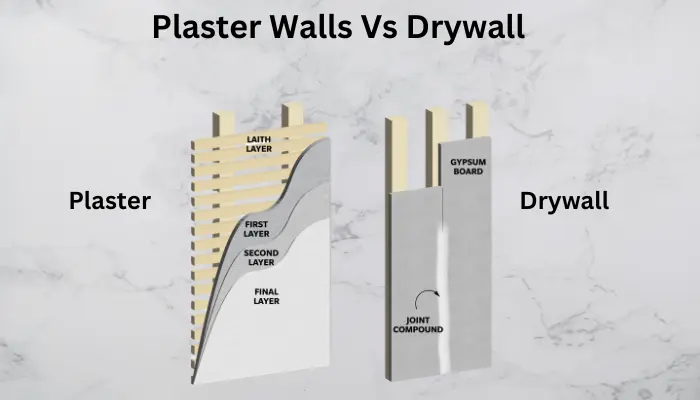Drywall and plaster are two common materials used for interior walls. They both have their pros and cons.
You can paint both plaster and drywall to achieve the desired color and finish. However, plaster walls require more careful preparation and specialized painting techniques.
Using simple tests, homeowners and contractors can tell whether the walls are plaster or drywall. Check for hairline cracks, flaking paint and if the wall produces a dense sound when tapped.

Plaster Walls Vs Drywall: Advantages and Disadvantages
Here are the advantages and disadvantages of both types. Read on to determine which one is best for your home projects.
Advantages and Disadvantages of Drywall
It wasn’t that long ago when plaster walls were a standard choice for interior construction. Older homes may have plaster walls, but modern homes often use drywall for construction and renovations.
Drywall, also known as plasterboard and Sheet rock, is a modern construction material used in drywall installation that consists of a sheet of gypsum plaster with a paper coating. It has several advantages over traditional plaster. For one, it’s easier to install and dries much faster. It also provides better sound resistance and insulation.
Additionally, drywall is fire-resistant and more durable than plaster. However, the disadvantages of drywall are numerous as well. Not as flexible as plaster, which can result in cracking.
Also less sturdy, hitting or bumping can easily damage it. Finally, drywall is not as recyclable as plaster and can cause environmental damage when people dispose of it improperly.
Homeowners should weigh the advantages and disadvantages of each type of wall. This will help them select the most suitable option for their property. Ultimately, it is important for homeowners to make an informed decision.
Advantages and Disadvantages of Plaster
Plastering is one of the oldest building techniques. Its versatility and durability make it ideal for historic renovation projects. It also achieves a more varied aesthetic than drywall. It can be expensive, however, because of the materials and skilled labor involved in its application.
Drywall, on the other hand, is less expensive and much faster to install. Its main ingredient is gypsum plaster pressed between heavy paper. It became extremely popular in the mid-20th century is now the most common wall covering in North America.
Plaster walls bend easily and are suitable for curved surfaces, making them ideal for older homes with unique designs. Using metal lath instead of wood lath strips can make them even more durable. Its high density makes it more soundproof than drywall.
The downside of plaster is that it can crack if the underlying structure is unstable. It can also be difficult to hang pictures and other wall décor. Also harder to repair than drywall. Water can also damage plaster because it is brittle.
Is Plaster Better Than Drywall ?
Many people often consider plaster walls a better choice than drywall. They offer higher quality, fireproofing and soundproofing, but can also be a hassle to install.
Plaster is extremely dense and lacks hollow spaces, which makes it exceedingly difficult for sound to pass through it. Also much more resistant to scratches compared to drywall. As a result, plaster walls tend to look more polished and refined than drywall.
Manufacturers create drywall by pressing gypsum and other materials between two paper sheets to make a panel. The most common building material today, but it wasn’t always this way. People built older homes and buildings with plaster and lath. Workers nailed wood strips called lathe to studs and added layers of plaster on top.
When choosing between drywall and plaster, contractors and homeowners should weigh the advantages and disadvantages of each option. Drywall costs less than plaster but its brittleness can easily lead to damage.
Applications for Drywall Installation
Drywall is often used in modern homes. It allows homeowners to easily customize their interior with paint or wallpaper. It also offers a smooth surface that accommodates different textures and is generally more resistant to damage than plaster.
People commonly used plaster walls in older homes and historic buildings that predate the widespread adoption of drywall. These walls are thicker and more durable than drywall, but they can still sustain some damage.
While it is possible to hang items like picture frames from plaster walls, using tacks or nails can cause holes. Similarly, it is not a good idea to use a hammer on plaster, as this can cause dents or cracks in the wall.
Ultimately, choosing between plaster and drywall comes down to the needs of the building project and its occupants. To finish a construction project quickly, opt for drywall over other materials such as framing, plumbing, and wiring. Faster to install than plaster and doesn’t require as much labor-intensive preparation.
Applications for plaster walls
Drywall is often the choice for modern renovations. A more economical option that provides better sound proofing than plaster walls.
However, there are many applications for plaster. This pliable material can mold into unique architectural details and designs. Experienced plaster professionals are like master craftsmen, creating beautiful details to enhance different styles.
You can apply plaster over metal lath, which is great for remodeling old homes. Plaster can also be used on a metal frame wall, making it more fire-resistant than drywall.
While modern plaster is mostly of gypsum, sand and water, it can be mixed to create different types of finishes. For instance, artisans make tadelakt, a Moroccan plaster, using lime plaster and black soap derived from olives.
Plaster Walls and Drywall Installation Services
Before making a decision, weigh the pros and cons of plaster vs drywall material carefully. Once you’ve made your choice, our expert team at ROA Drywall is ready to help! We have experience and training to handle your drywall or plaster installation needs.
We can help you complete one more task on your to-do list. Contact us to schedule a convenient appointment and let us handle the rest!